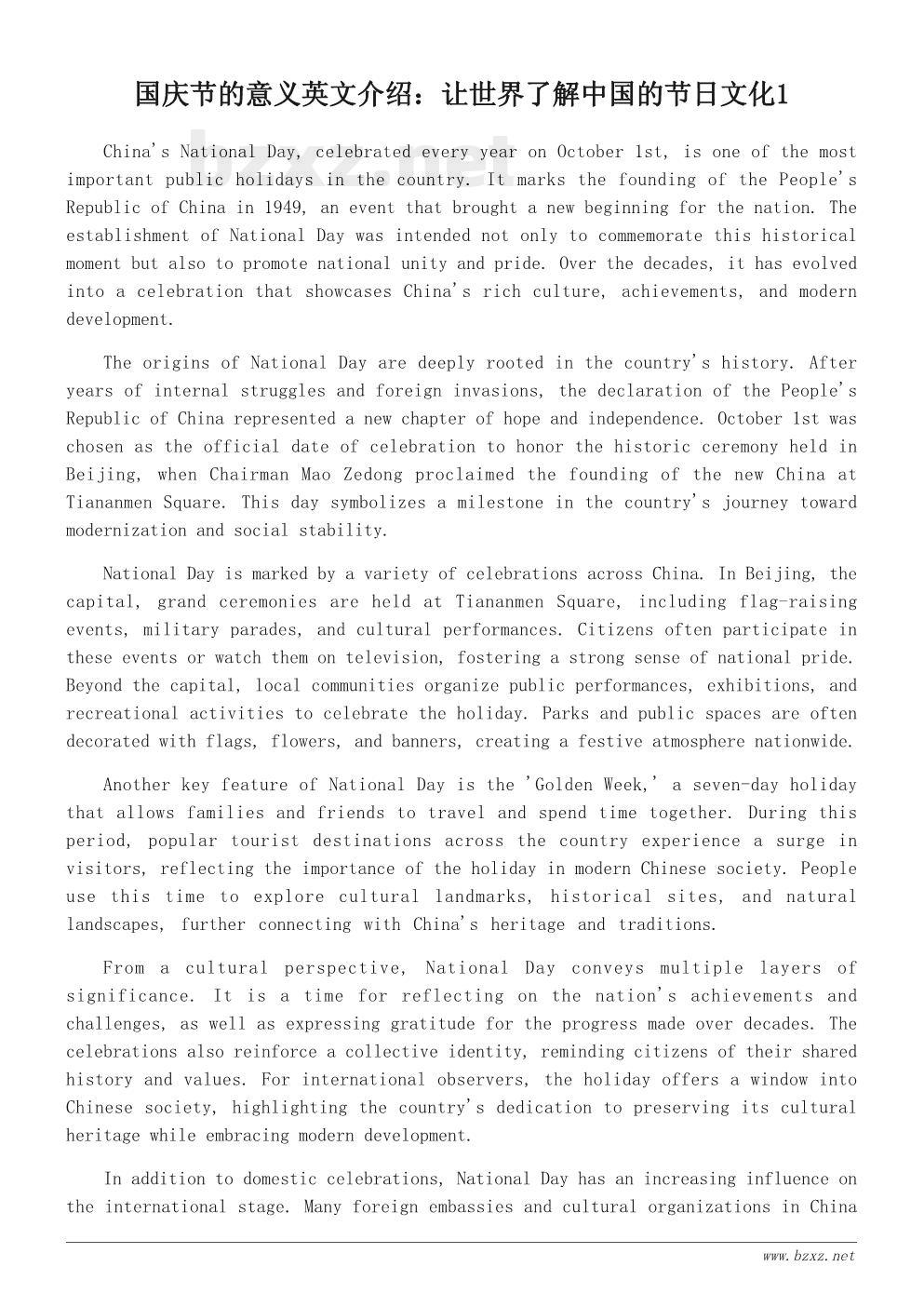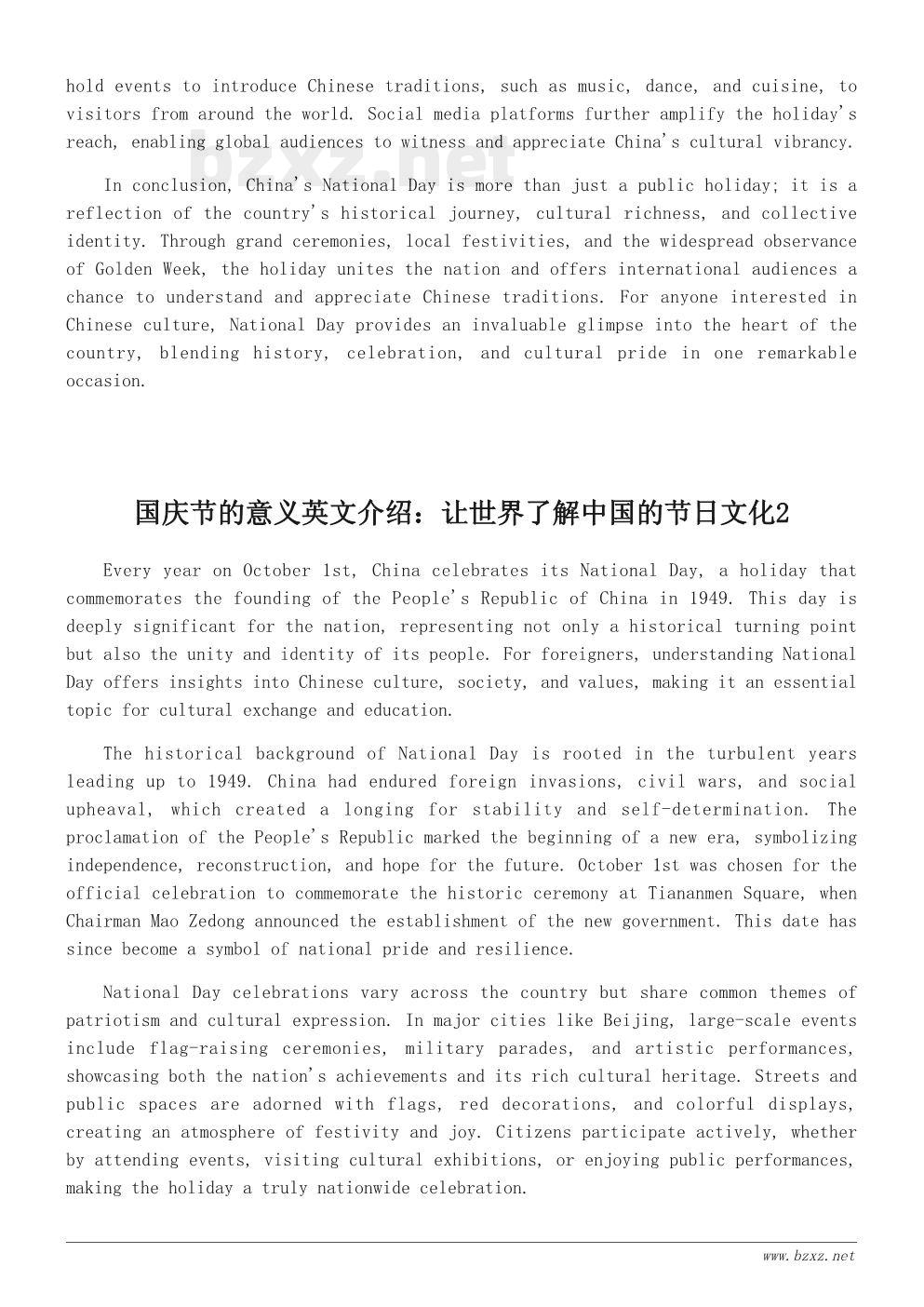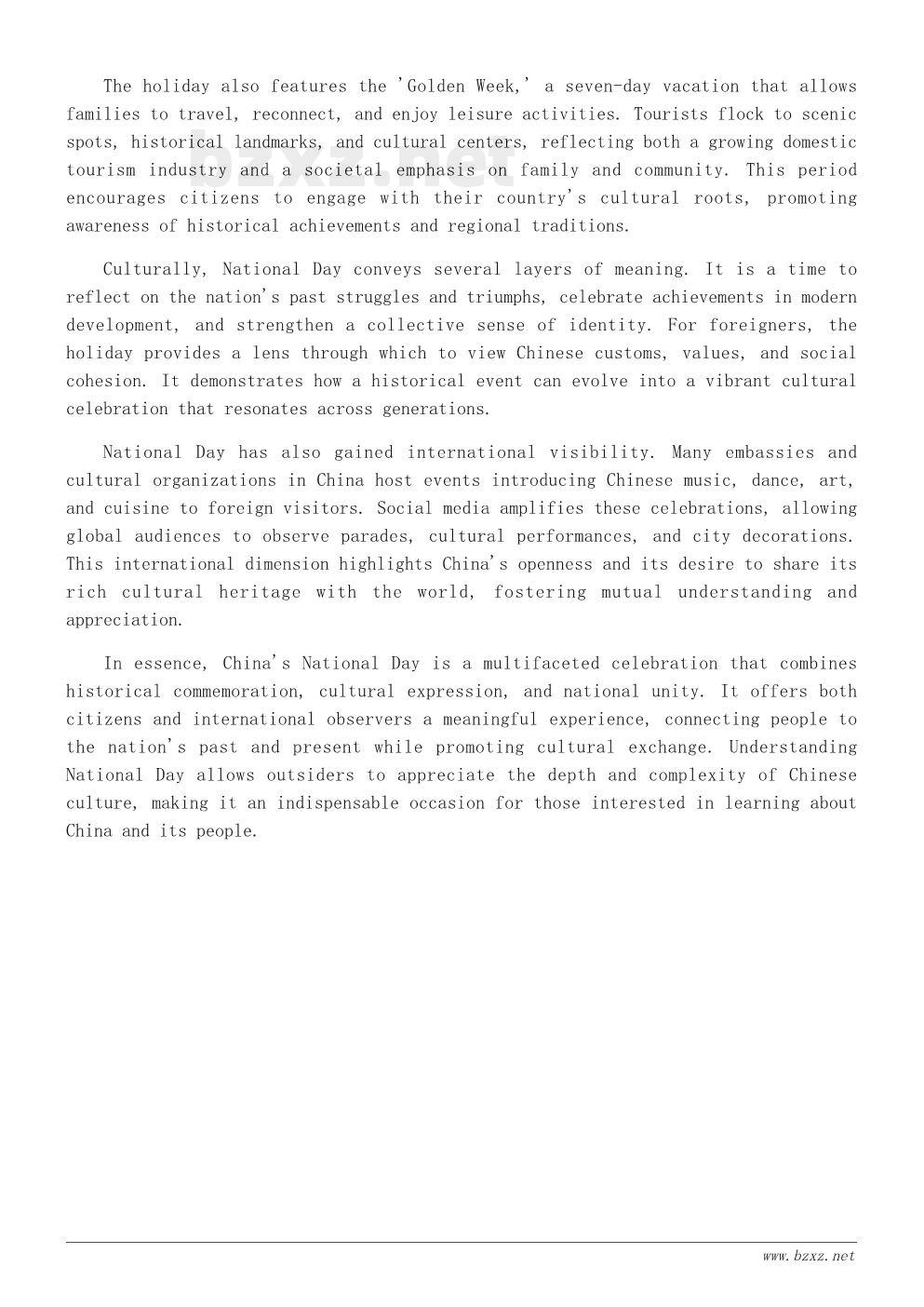基本信息
文档名称:国庆节的意义英文介绍:让世界了解中国的节日文化
文档类别:节日文化介绍
文章篇数:2篇
所属合集:国庆节
下载格式:zip (包含docx pdf)
文件大小:859.39 KB
下载方式:免费下载
文章题纲
本文将用英文介绍中国国庆节的历史起源、庆祝方式及其文化意义,帮助外国朋友了解这一重要节日。内容包括国庆节设立的背景、节日象征意义、全国各地庆祝活动以及国庆节在国际视野中的影响。适合用于英语学习或文化交流场景。
文章列表
文章内容
国庆节的意义英文介绍:让世界了解中国的节日文化1
China's National Day, celebrated every year on October 1st, is one of the most important public holidays in the country. It marks the founding of the People's Republic of China in 1949, an event that brought a new beginning for the nation. The establishment of National Day was intended not only to commemorate this historical moment but also to promote national unity and pride. Over the decades, it has evolved into a celebration that showcases China's rich culture, achievements, and modern development.
The origins of National Day are deeply rooted in the country's history. After years of internal struggles and foreign invasions, the declaration of the People's Republic of China represented a new chapter of hope and independence. October 1st was chosen as the official date of celebration to honor the historic ceremony held in Beijing, when Chairman Mao Zedong proclaimed the founding of the new China at Tiananmen Square. This day symbolizes a milestone in the country's journey toward modernization and social stability.
National Day is marked by a variety of celebrations across China. In Beijing, the capital, grand ceremonies are held at Tiananmen Square, including flag-raising events, military parades, and cultural performances. Citizens often participate in these events or watch them on television, fostering a strong sense of national pride. Beyond the capital, local communities organize public performances, exhibitions, and recreational activities to celebrate the holiday. Parks and public spaces are often decorated with flags, flowers, and banners, creating a festive atmosphere nationwide.
Another key feature of National Day is the 'Golden Week,' a seven-day holiday that allows families and friends to travel and spend time together. During this period, popular tourist destinations across the country experience a surge in visitors, reflecting the importance of the holiday in modern Chinese society. People use this time to explore cultural landmarks, historical sites, and natural landscapes, further connecting with China's heritage and traditions.
From a cultural perspective, National Day conveys multiple layers of significance. It is a time for reflecting on the nation's achievements and challenges, as well as expressing gratitude for the progress made over decades. The celebrations also reinforce a collective identity, reminding citizens of their shared history and values. For international observers, the holiday offers a window into Chinese society, highlighting the country's dedication to preserving its cultural heritage while embracing modern development.
In addition to domestic celebrations, National Day has an increasing influence on the international stage. Many foreign embassies and cultural organizations in China hold events to introduce Chinese traditions, such as music, dance, and cuisine, to visitors from around the world. Social media platforms further amplify the holiday's reach, enabling global audiences to witness and appreciate China's cultural vibrancy.
In conclusion, China's National Day is more than just a public holiday; it is a reflection of the country's historical journey, cultural richness, and collective identity. Through grand ceremonies, local festivities, and the widespread observance of Golden Week, the holiday unites the nation and offers international audiences a chance to understand and appreciate Chinese traditions. For anyone interested in Chinese culture, National Day provides an invaluable glimpse into the heart of the country, blending history, celebration, and cultural pride in one remarkable occasion.
国庆节的意义英文介绍:让世界了解中国的节日文化2
Every year on October 1st, China celebrates its National Day, a holiday that commemorates the founding of the People's Republic of China in 1949. This day is deeply significant for the nation, representing not only a historical turning point but also the unity and identity of its people. For foreigners, understanding National Day offers insights into Chinese culture, society, and values, making it an essential topic for cultural exchange and education.
The historical background of National Day is rooted in the turbulent years leading up to 1949. China had endured foreign invasions, civil wars, and social upheaval, which created a longing for stability and self-determination. The proclamation of the People's Republic marked the beginning of a new era, symbolizing independence, reconstruction, and hope for the future. October 1st was chosen for the official celebration to commemorate the historic ceremony at Tiananmen Square, when Chairman Mao Zedong announced the establishment of the new government. This date has since become a symbol of national pride and resilience.
National Day celebrations vary across the country but share common themes of patriotism and cultural expression. In major cities like Beijing, large-scale events include flag-raising ceremonies, military parades, and artistic performances, showcasing both the nation's achievements and its rich cultural heritage. Streets and public spaces are adorned with flags, red decorations, and colorful displays, creating an atmosphere of festivity and joy. Citizens participate actively, whether by attending events, visiting cultural exhibitions, or enjoying public performances, making the holiday a truly nationwide celebration.
The holiday also features the 'Golden Week,' a seven-day vacation that allows families to travel, reconnect, and enjoy leisure activities. Tourists flock to scenic spots, historical landmarks, and cultural centers, reflecting both a growing domestic tourism industry and a societal emphasis on family and community. This period encourages citizens to engage with their country's cultural roots, promoting awareness of historical achievements and regional traditions.
Culturally, National Day conveys several layers of meaning. It is a time to reflect on the nation's past struggles and triumphs, celebrate achievements in modern development, and strengthen a collective sense of identity. For foreigners, the holiday provides a lens through which to view Chinese customs, values, and social cohesion. It demonstrates how a historical event can evolve into a vibrant cultural celebration that resonates across generations.
National Day has also gained international visibility. Many embassies and cultural organizations in China host events introducing Chinese music, dance, art, and cuisine to foreign visitors. Social media amplifies these celebrations, allowing global audiences to observe parades, cultural performances, and city decorations. This international dimension highlights China's openness and its desire to share its rich cultural heritage with the world, fostering mutual understanding and appreciation.
In essence, China's National Day is a multifaceted celebration that combines historical commemoration, cultural expression, and national unity. It offers both citizens and international observers a meaningful experience, connecting people to the nation's past and present while promoting cultural exchange. Understanding National Day allows outsiders to appreciate the depth and complexity of Chinese culture, making it an indispensable occasion for those interested in learning about China and its people.
小提示:上面此文档内容仅展示完整文档里的部分内容,若需要下载完整文档请点击免费下载完整文档
文档图片预览



